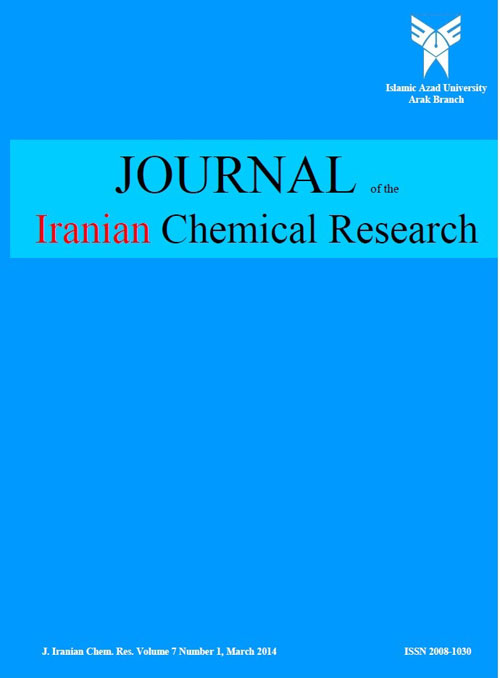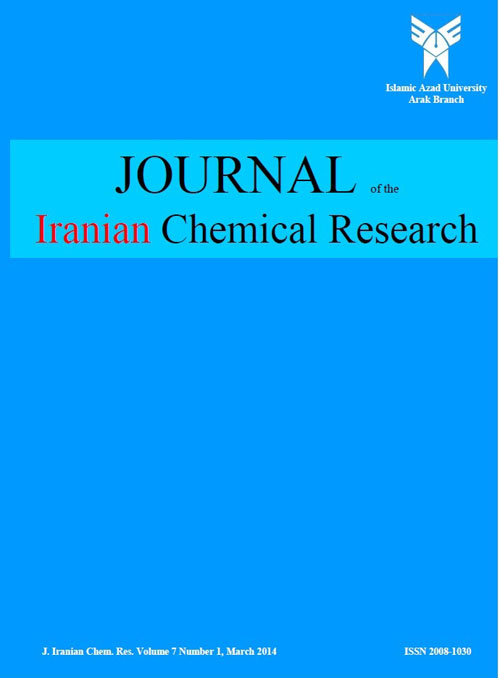فهرست مطالب

Journal of the Iranian Chemical Research
Volume:2 Issue: 3, Summer 2009
- تاریخ انتشار: 1388/06/30
- تعداد عناوین: 8
-
Pages 157-162The electrochemical behaviour of lead electrode in hydrochloride solution containing various oxo-anions at different concentrations was studied by using of cyclic voltammetry (CV) method.
Results obtained show that the addition of these inorganic compounds decreases the anodic and cathodic currents peaks according to the following order: H2PO4 - > HPO4 2-> SO4 2-. Its revealed also that the cathodic current density related to the reduction of Pb2 ions dissolved in solution decreases with the oxo-anions concentration. When the addition of sulphates ions concentration reaches 0.34 mol L-1, the formation of PbSO4 is highly favoured. Therefore, the interstices between the crystals of PbSO4 encourage the dissolution of lead and the formation of insoluble PbCl2 layer on the lead surface involving the passivation phenomenon.Keywords: Corrosion, lead, Oxo, anions, Hydrochloride acid, Cyclic voltammetry -
Pages 163-171Polypyrrole (PPy/Cl) and polyaniline (PAni/Cl) synthesized chemically onto sawdust (SD)was used for removal of thiocyanate (SCN-) ions from aqueous solutions. The effect of some important parameters such as pH, initial concentration, sorbent dosage, and contact time on uptake of SCN- was investigated. PPy/SD was found to be much more effective sorbent than PAni/SD for uptake SCN- from aqueous solutions. Removal of SCN- ions using PPy/Cl is supposed to be occurred mostly via ion exchange process at the surface of polymer coated onto sawdust as a very thin film. Desorption studies were also carried out for figuring out the possibility of the regeneration and reuse of the exhausted adsorbent. A proposed mechanism based on interesting anion exchange properties of the PPy/Cl has been discussed. It was found that polypyrrole conducting polymers doped with releasable counterions can be used for used to remove some anions via ion exchange process under simple open circuit conditions. The finding in this paper shows the promising application of polypyrrole conducting polymers in future water or wastewater purification technology.Keywords: Thiocyanate ion, Removal, Polypyrrole, Polyaniline, Sawdust, Desorption
-
Pages 173-182In present studies the synthesis, characterization and biological properties of oxovanadium(IV) coordination compounds of 4[N-(4′-ethylbenzalidene)amino] antipyrine thiosemicarbazone (EBAAPTS) and 4[N-(2′,4′-dimethylbenzalidene)amino] antipyrine thiosemicarbazone (DMBAAPTS) with the general composition VOX2L (X = C1-, Br-, I-, NO3-or NCS-) and VO(CIO4)2(L)H2O (L = EBAAPTS or DMBAAPTS) are described . All the complexes were characterized by elemental analyses, molar mass, molar conductance, magnetic susceptibility, infrared and electronic spectra. In all these complexes, both the thiosemicarbazones behave as neutral tridentate (N, N, S) ligands. The thermal properties of the representative complexes are also reported. The most probable geometry of the complexes is proposed.Keywords: Oxovanadium (IV) complexes, thiosemicarbazone, Biological activity, Mixed ligand complexes
-
Pages 183-187A new, convenient, efficient, and cost-effective one-pot synthesis of 1Hphenanthro[ 9,10]imidazol-2-yl from phenanthraquinone and aldehydes, using sulfuric acid immobilized on silica as catalyst is described. The present methodology offers several advantages such as excellent yields, simple procedure, shorter reaction times, the use of inexpensive reagents, easy recovery and eco-friendly. In addition to these, 2-alkyl phenanthrimidazole is obtained from triethyl orthoesters in good yields.Keywords: 1H, phenanthro[9, 10]imidazol, 2, yl, Phenanthraquinone, Triethyl orthoesters, Sulfuric acid
-
Pages 189-194Cross linking of high density polyethylene (HDPE) was first performed via high energy 10 Mev electron beam (EB) irradiation. HDPE was also cross linked with Dicumyle peroxide (DCP).The gel content of samples was determined by solvent extraction. Degree of cross linking was evaluated by hot set apparatus; as well .In order to clarify the effect of nature of cross linking, correlation of electrical properties such as volume resistively, dielectric constant, dielectric strength with the type of cross linking system was made. It was found that, in the same amount of gel content, electrical properties of samples cross linked by the two methods, differed.Keywords: electron beam, Cross linking, High density polyethylene, Electrical properties
-
Pages 195-210The thermal degradation of polyethylene (PE) was carried out in the absence and presence of catalystes X-Zeolite and Silica-Alumina at different temperatures. The optimum PE/Catalysis ratio was 0.25:0.05 g/g, which produced highest degradation value. PE and PE/Catalysis were characterized by thermogravimetric analysis. The thermal degradation properties of polymer have been studied by Infrared spectroscopyFT-IR. Experimental data indicated that the presence of catalysis greatly increased the rate of degradation of PE. The activation energy of degradation for pure polyethylene and polyethylene in presence catalysises was calculated by Arrhenius equation and Ozawa method. Activation energy follows the order PEKeywords: Thermal degradation, Polyethylene, X, Zeolite, Silica, Alumina, Activation energies
-
Pages 211-219Benign prostatic hyperplasia (BPH) is a non-malignant enlargement of the prostate gland. It is a leading disorder of the elderly male population. Excessive production of dihydrotestosterone has been implicated in this pathological condition. Steroidal 5α-reductase is a membrane bound NADPH dependent enzyme which is responsible for the conversion of testosterone (T) to dihydrotestosterone (DHT). Therefore, inhibition of production of DHT by 5α-reductase inhibitors is an important approach for the treatment of BPH. The proposed 17-oxo-17a-aza-Dhomo- 3,5-seco-steroids (17-20) have been synthesized using diosgenin as the starting material. Diosgenin was converted to 17-oxo-3, 5-seco-4-nor-androstan-3-oic acid following six steps: Oppenauer oxidation, Lemieux-von Rudloff oxidation, Wolff-Kishner reduction, Marker degradation, oximation and Beckmann rearrangement. 17-Oxo-3, 5- seco-keto acid was then converted to 17-oxo-17a-aza-D-homo-3, 5-seco-4-nor-androstan-3-oic acid by oximation followed by Beckmann rearrangement. The resulted seco-keto acid was then treated with thionyl chloride and the respective amines and phenols to get the desired 3, 5-seco-steroidal amides (17-18) and esters (19-20) respectively.Keywords: BPH, DHT, Diosgenin, 5?, Reductase, Seco, steroids
-
Pages 221-230Low-cost grapefruit peel (Agricultural Waste) was used for removal of reactive blue19 dye from aqueous solutions. The process was studied as a function of contact time, initial dye concentration and pH. Adsorption process was attained to the equilibrium within 45 min for initial dye concentrations of 50, 75, and 100 mg L-1. An acidic medium was the optimum condition for adsorption of dye at room temperature. The maximum dye removal of 83.56 % could be achieved at initial pH 2 using adsorbent dosage of 0.5 mg in 150 ml (50 mg L-1 dye concentration) and agitation rate of 180 rpm. The adsorption capacity was found to be about 12.534 mg g-1. The isotherm data could be well described via Langmuir equation with the correlation coefficient of 0.986 in dye concentration range of 50-100 mg L-1 at 25 ◦C. Kinetic studies revealed that the experimental data correlated well with pseudo second-order model possessing regression coefficient of R2 ≥ 0.999. Scanning Electron Micrographs provided a supporting evidence for efficient dye sorption onto grapefruit peel.Keywords: agricultural waste, Grapefruit Peel, Adsorption, Reactive blue19


